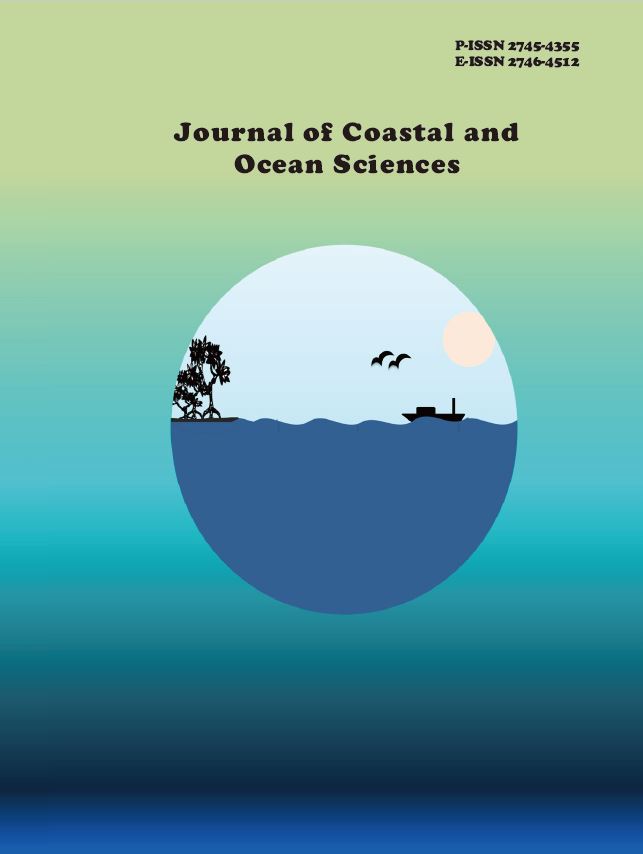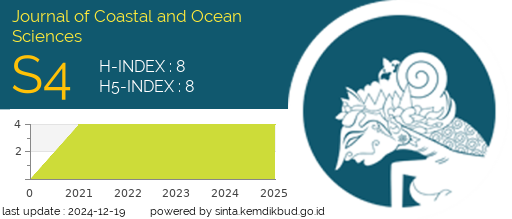Organic Carbon Stock in Sediment of the Rehabilitated Mangrove Ecosystem in Kedabu Rapat Village, Meranti Islands Regency
DOI:
https://doi.org/10.31258/jocos.6.2.94-101Keywords:
organic carbon, mangrove rehabilitation, sediment depth, mangrove densityAbstract
Global climate change caused by increasing atmospheric CO₂ emissions threatens coastal ecosystems, including mangrove forests that function as carbon sinks. Kedabu Rapat Village in Meranti Islands Regency has implemented a mangrove rehabilitation program since 2017 to overcome coastal abrasion and restore the ecosystem. This study examines mangrove density, organic carbon stock in sediment, the relationship between density and carbon stock, and variations in carbon stock between sediment depths. The study was conducted at three stations according to the year of rehabilitation using a survey method with sediment sampling as deep as 30 cm, Organic carbon was analyzed using the LOI method. The study's results identified one mangrove species, Avicennia alba, from the Acanthaceae family, which dominated all observation stations. Vegetation density is classified as very dense, averaging 7,911 ind/ha, with the highest density at Station 1 (8,935 ind/ha). All stations' average sediment carbon stock reached 117.23 tons/ha, with the highest value at Station 3 (135.19 tons/ha) and the lowest at Station 1 (96.97 tons/ha). Statistical analysis revealed a weak correlation (r = 0.218; p > 0.05) between mangrove density and sediment carbon stock, indicating that other environmental factors, such as sedimentation and sediment input, play a more significant role. The distribution of carbon stock by depth was relatively uniform, ranging from 38.25 to 40.58 tons/ha. These results indicate that external factors are also determinants of carbon absorption rates
Downloads
References
[SNI] Standar Nasional Indonesia. 2011. Pengukuran dan Perhitungan Cadangan Karbon-Pengukuran Lapangan untuk Penaksiran Cadangan Karbon Hutan. Jakarta. Badan Standarisasi Nasional. 14p.
Donato, D.C., Kauffman, J.B., Murdiyarso, D., Kurnianto, S., Stidham, M., & Kanninen, M. (2011). Mangroves among the Most Carbon-Rich Forests in the Tropics. Nature geoscience, 4(5): 293-297.
Efriyeldi, E., Mulyadi, A., & Samiaji, J. (2021). Pertumbuhan Api-Api (Avicennia alba) dan Kelimpahan Epifauna Bentik di Kawasan Rehabilitasi Mangrove Desa Kedaburapat Kabupaten Kepulauan Meranti. Dinamika Lingkungan Indonesia, 8(2): 113-122.
Farhana, F., Zulfikar, A., & Koenawan, C.J. (2016). Analisis Kesesuaian Lahan pada Kawasan Rehabilitasi Mangrove di Desa Temburun Kabupaten Kepulauan Anambas. Repository UMRAH, 1-14.
Fikriyani, M. (2013). Evaluasi Program Rehabilitasi Mangrove di Pesisir Desa Bedono Kecamatan Sayung Kabupaten Demak. Ruang, 2(1): 81-90.
Hendrayana, H., Setiawan, P.M., Samudra, S.R., & Raharjo, P. (2023). Konsentrasi Karbon Sedimen Mangrove di Muara Kali Ijo, Kebumen. Journal of Marine Research, 12(2): 315–322.
Heriyanto, N.M., & Subiandono, E. (2016). Peran Biomasa Mangrove dalam Menyimpan Karbon di Kubu Raya, Kalimantan Barat. Jurnal Analisis Kebijakan, 13(1): 1-12.
Hickmah, N., Maslukah, L., Wulandari, S.Y., Sugianto, D.N., & Wirasatya, A. (2021). Kajian Stok Karbon Organik dalam Sedimen di Area Vegetasi Mangrove Karimunjawa. Indonesian Journal of Oceanography, 3(4): 88-95.
Isnaini, S., Amin, B., & Efriyeldi, E. (2020). Comparison of Carbon Reserves in Mangrove Sonneratia alba and Nypa fruticans pratipin Pangkalan Jambi Village, Bengkalis District Riau Province. Journal of Coastal and Ocean Sciences, 1(1): 41-50.
Kauffman, J.B., & Donato, D.C. (2012). Protocols for the Measurement, Monitoring and Reporting of Structure, Biomass and Carbon Stocks in Mangrove Forest. Bogor, CIFOR. 37 p.
Keputusan Menteri Negara Lingkungan Hidup Nomor 51. (2004). Mutu Air Laut Menteri Negara Lingkungan Hidup. Kementerian RI. Jakarta.
Mucha, A.P., Vasconcelos, M.T.S.D., & Bordalo, A.A. (2003). Macrobenthic Community in the Douro Estuary: Relations with Trace Metals and Natural Sediment Characteristics. Environmental Pollution, 121(1): 169–180.
Murdiyarso, D., & Ambo-Rappe, R. (2022). Rehabilitasi Kawasan Pesisir untuk Mitigasi Perubahan Iklim: Peranan Mangrove dan Penurunan Emisi Tingkat Sub-Nasional. Working Paper, 11. Bogor, Indonesia: CIFOR. 50 p.
Murdiyarso, D., Purbopuspito, J., Kauffman, J.B., Warren, M.W., Sasmito, S., Donato, D.C., Manuri, S., Krisnawati, H., Taberima, S., & Kurnianto, S. (2015). The Potential of Indonesian Mangrove Forest for Global Climate Change Mitigation. Nature Climate Change, 5(12): 1089-1092.
Pratiwi, D., Hartoko, A., & Febrianto, S. (2023). Potensi Serapan Karbon Hutan Mangrove, Kulon Progo, Yogyakarta. Jurnal Kelautan Nasional, 18(2):99-112
Sakmiana, A.F., Paputungan, M.S., Kusumaningsih, W., & Rahmawati, S. (2023). Estimasi Konsentrasi dan Stok Karbon Organik pada Sedimen Lamun di Desa Selangan, Kalimantan Timur. Journal of Marine Research, 12(3): 483-492.
Wantesan, A.S. (2013). Kondisi Kualitas Perairan dan Substrat Dasar sebagai Faktor Pendukung Aktivitas Pertumbuhan Mangrove di Pantai Pesisir Desa Bassan I, Kabupaten Minahasa Tenggara. Jurnal Ilmiah Platax, 1(4): 204-209.
Downloads
Published
Issue
Section
License
Copyright (c) 2025 Bintang Dwi Cahyo, Efriyeldi Efriyeldi, Bintal Amin (Author)

This work is licensed under a Creative Commons Attribution 4.0 International License.





